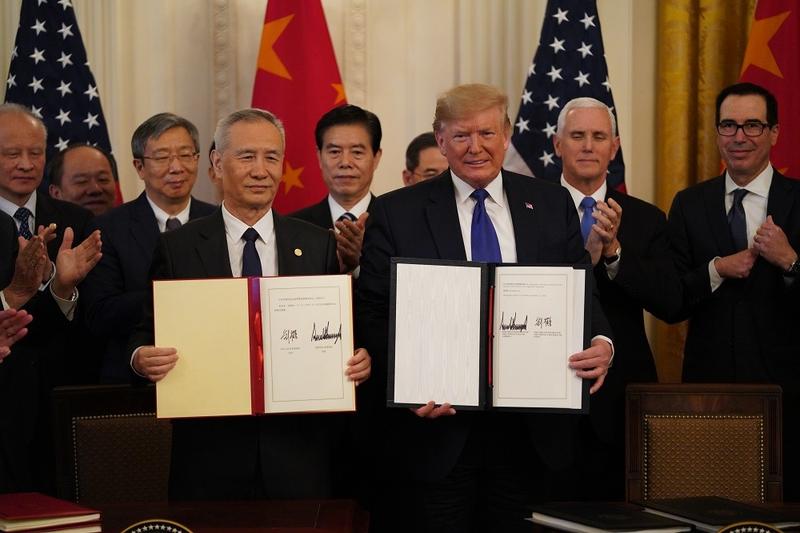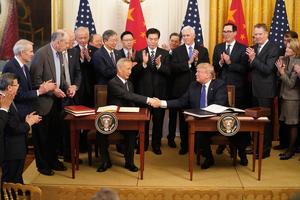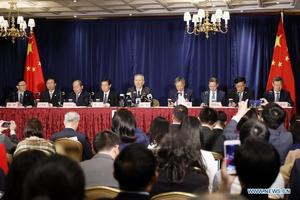 US President Donald Trump and Chinese Vice-Premier Liu He, who is also a member of the Political Bureau of the Communist Party of China Central Committee and chief of the Chinese side of the China-US comprehensive economic dialogue, show the signed China-US phase-one economic and trade agreement during a ceremony at the East Room of the White House in Washington D.C., the United States, Jan 15, 2020. (PHOTO / XINHUA)
US President Donald Trump and Chinese Vice-Premier Liu He, who is also a member of the Political Bureau of the Communist Party of China Central Committee and chief of the Chinese side of the China-US comprehensive economic dialogue, show the signed China-US phase-one economic and trade agreement during a ceremony at the East Room of the White House in Washington D.C., the United States, Jan 15, 2020. (PHOTO / XINHUA)
The United States and China signed the long-awaited phase-one trade deal at the White House on Thursday morning Beijing time, capping a bruising battle that had lasted nearly two years.
The signing signaled a thaw in economic and trade relations between the world’s two largest economies.
The trade truce is widely expected to reduce the uncertainties that have dampened the business investment mood in both countries and around the world
The deal, agreed to in mid-December after a dozen rounds of negotiations led by China’s top trade negotiator and Vice-Premier Liu He and US Trade Representative Robert Lighthizer, was finally closed at a ceremony in the East Room of the White House that was attended by leading US officials and about 200 representatives of business, government and diplomatic circles.
The trade truce came 22 months after tensions flared between the world’s top two economies in March 2018. It is widely expected to reduce the uncertainties that have dampened the business investment mood in both countries and around the world.
READ MORE: World Bank sees benefits of US-China trade thaw
The signing of the phase-one deal will be beneficial to both countries and help bolster the global economy, analysts said. They also urged that concerted efforts be made to resolve potential uncertainties in the future.
Wei Jianguo, vice-president of the China Center for International Economic Exchanges in Beijing, said, “The conclusion of the pact benefits consumers and companies in both China and the US, and it will help restore confidence in the foundering world economy.”
The deal proves that the two economies complement each other and that cooperation is the best choice for them, he said.
Looking ahead, it may be inevitable that China and the US will “step on each other’s feet”, but the conclusion of the phase-one deal will lead to dialogue in more fields and at deeper levels, Wei said.
 US President Donald Trump and Chinese Vice-Premier Liu He, who is also a member of the Political Bureau of the Communist Party of China Central Committee and chief of the Chinese side of the China-US comprehensive economic dialogue, shake hands after signing the China-US phase-one economic and trade agreement during a ceremony at the East Room of the White House in Washington D.C., the United States, Jan 15, 2020. (PHOTO / XINHUA)
US President Donald Trump and Chinese Vice-Premier Liu He, who is also a member of the Political Bureau of the Communist Party of China Central Committee and chief of the Chinese side of the China-US comprehensive economic dialogue, shake hands after signing the China-US phase-one economic and trade agreement during a ceremony at the East Room of the White House in Washington D.C., the United States, Jan 15, 2020. (PHOTO / XINHUA)
Liu Liu, a macroeconomics researcher at China International Capital Corp, a leading investment banking firm, said that because the pact was concluded, “trade between China and the US will pick up”.
“In general, the easing of Sino-US trade frictions will reduce external uncertainties and benefit global trade and the world economy,” Liu said.
READ MORE: US Chamber urges Washington to tear down trade barriers
Consumer demand is expected to improve at home and abroad this year, along with trade growth, while the exchange rate of the yuan will have more support from improving fundamentals, he said.
Between November and December, growth of China’s imports from the US recovered to some extent. US shipments to China rose by 9.1 percent year-on-year to reach 78.83 billion yuan (US$11.44 billion) in December.
Exports of US agricultural products to China reached 14.1 billion yuan last month, climbing 200 percent year-on-year. In the same month, China imported 23,000 automobiles from the US, up 150 percent from the same period a year earlier.
 Vice-Premier Liu He, who is also a member of the Political Bureau of the Communist Party of China Central Committee and chief of the Chinese side of the China-US comprehensive economic dialogue, speaks at a press conference following the signing of the China-US phase-one economic and trade agreement in Washington D.C., the United States, Jan 15, 2020. (PHOTO / XINHUA)
Vice-Premier Liu He, who is also a member of the Political Bureau of the Communist Party of China Central Committee and chief of the Chinese side of the China-US comprehensive economic dialogue, speaks at a press conference following the signing of the China-US phase-one economic and trade agreement in Washington D.C., the United States, Jan 15, 2020. (PHOTO / XINHUA)
Bi Jiyao, deputy director of the Academy of Macroeconomic Research of the National Development and Reform Commission, said potential challenges persist this year, and coping with them will require more effort.
Also, protectionism may reignite, which, together with pending reforms of the World Trade Organization, will make it difficult for companies worldwide to make long-term investments, Bi said.
ALSO READ: Trade conflict may not intensify again
On Tuesday, before the signing of the deal, Vice-Premier Liu He said that Beijing and Washington will work together to obtain tangible results going forward, according to Xinhua.
Liu told International Monetary Fund President Kristalina Georgieva and some US representatives during a meeting in Washington that the deal would benefit both countries and the world.
Liu also said China and the US can work together in a win-win relationship despite differences in their political and economic models.


